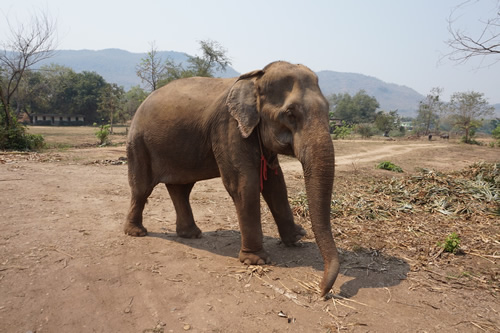Wildlife Volunteering in Thailand
Work with Wildlife Generally or Elephants Exclusively
By Erika Wedenoja
 |
| Volunteer to rescue elephants in Thailand. |
The local bus stopped at a gas station in town to let me off. Barely an hour later, I found myself riding an elephant into a local lake for bath time. This was to be a daily task for me as a volunteer at the Elephant
Refuge and Education Center in Thailand. The Elephant Center is run by Wildlife Friends of Thailand (WFFT), a nonprofit organization founded and directed by Edwin Wiek. With goals including the rescue
and rehabilitation of native animals, the Wildlife Rescue Center was opened in 2001, the Elephant Center in 2003. Both are on the grounds of a temple about 100 miles south of Bangkok, with the beach resorts of Cha-am and Hua
Hin nearby. Volunteers and educational visits are welcomed.
Volunteers can choose to work at either the Wildlife Center or the Elephant Center. Preferring to focus on one species, I chose the latter. The four females at the Elephant Center were once begging on city streets or living
in unsuitable conditions at elephant camps for tourists. Each elephant has her own mahout, or elephant keeper, whom the volunteers assist. As the mahouts spoke little English, they taught me enough to communicate with them and the elephants in
Thai.
At 6:30 a.m. we collected the large mammals from the surrounding forest, where they foraged overnight, and gave them a breakfast of banana tree trunks or pineapple plants. A couple hours later it was time to clean up and
feed again. Four elephants can fill a wheelbarrow full of dung in that amount of time. I soon felt like an elephant mommy.
In the early afternoon, we washed the elephants clean in the lake, taking care as they dunked and rolled playfully. Once they were cooled and cleansed, we rode them back into the forest for the night.
The elephants ate through their food supply every few days and then it was time to visit a nearby farmer’s field. The locals were happy to have us haul away remaining plants after the fruit had been picked.
While I settled into a standard daily routine with the elephants, volunteers who chose to work at the Wildlife Center had rotational duties. One day might include draining and scrubbing the ponds for the sun bears, another
might be collecting leaves to feed the monkeys as well as keeping their water bottles topped up. Much of the work involved cleaning and food preparation rather than physical contact in order to help the animals live as wildlife, not housepets.
Animals end up at the Wildlife Center for various reasons. Some were exotic pets, dumped when their owners tired of them. Others were confiscated from the illegal wildlife trade. Many animals had been exploited for entertainment,
obliged to pose for photos or perform tricks for tourists.
Whenever possible, wildlife is treated by on-site veterinary services and released back into the wild. Gibbon families live on islands in the nearby lake to minimize human contact and prepare them for life in their native
rainforest. Even when healthy, many animals must remain at the Wildlife Center as they have been raised in captivity and lack the skills to survive in the wild.
During my stay, we volunteers numbered about a dozen Europeans and North Americans, ranging in age from teens to sixties. We each shared a room and private bath with one other volunteer. While breakfast was a do-it-yourself
affair, a buffet of meat and vegetarian Thai dishes was prepared by the staff for lunch and dinner. The main building provided kitchen, dining room, TV, books, and movies. Further evening entertainment was a short walk away, in a 1-street town
with a weekly market, small shops, and two Internet cafes.
With one day off per week and moderate work schedules, there was plenty of free time to relax or watch the animals. The macaques (a monkey commonly found in Southeast Asia) never failed to threaten me, showing their teeth
or rumps as I walked by. The gibbons woke me with their early morning singing. The young sun bears, claws already several inches long, loved to climb, hanging upside down as they fought playfully. And the elephants, despite an imposing size,
were sensitive and affectionate. Nong Bo and Tia wrapped their trunks together in friendship, Kjaewta slapped hers on the ground when upset, Nam Phoun rested hers in her mouth when it got too heavy. Like me, many volunteers found it harder to
leave the animals than their fellow volunteers when their stay was done.
|
For More Info
News and information is available at Wildlife Friends of Thailand.
Preparation
Minimum age for volunteers is 18. No special skills are required, other than English speaking ability. Vaccinations against hepatitis A & B, diptheria, tetanus, and polio are a pre-requisite as a precaution
for the animals. Volunteers are needed year-round. While the weather is always hot and humid, the dry and cooler season from mid-November to March is more comfortable.
Transportation
WFFT can arrange a taxi service ahead of time from the airport or your hotel in Bangkok. However, I found it easy to take a taxi to the Southern Bus terminal (ask for Sai Tai Mai) in Bangkok and hop on a local
bus to Cha-am. Buses leave hourly throughout the day and the ride takes 2-3 hours. A taxi from the airport should cost no more than $10 and the bus ticket is around $3. Call upon arrival in Cha-am and WFFT will send a driver to pick you
up. This pick up is free but you will need about $10 for a taxi back to Cha-am when you leave.
|
Erika Wedenoja lives in Portland, OR when she is not exploring the rest of the world.
|
